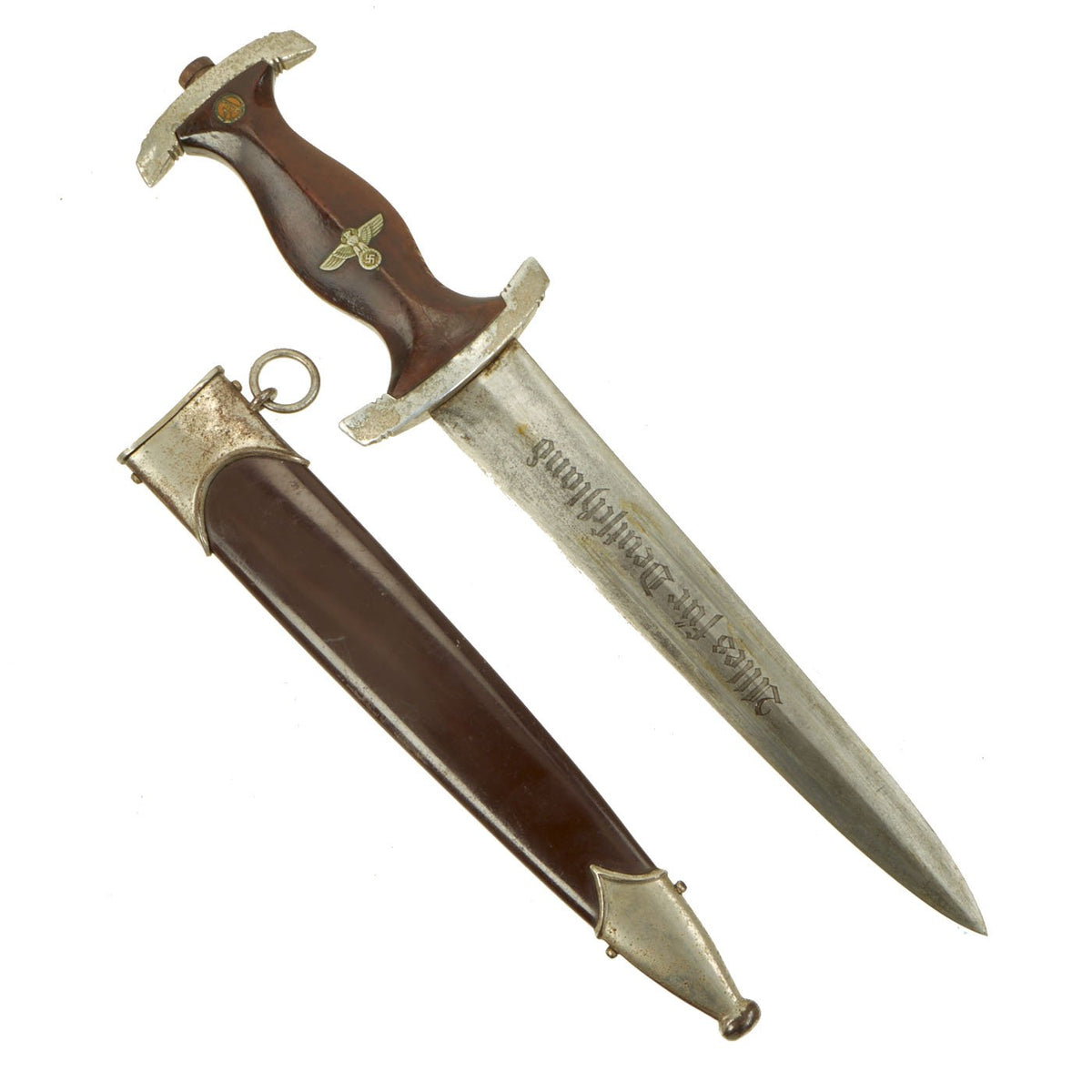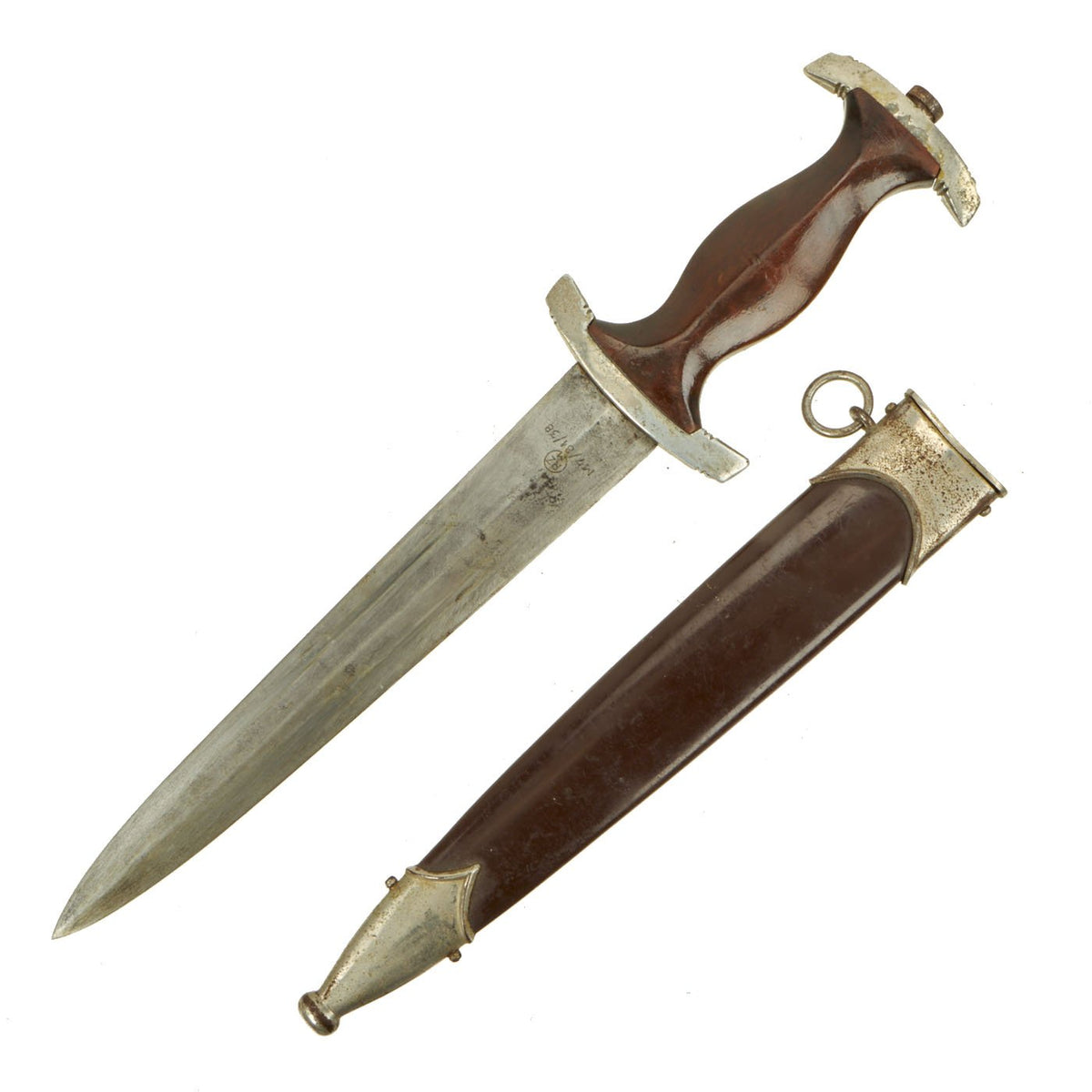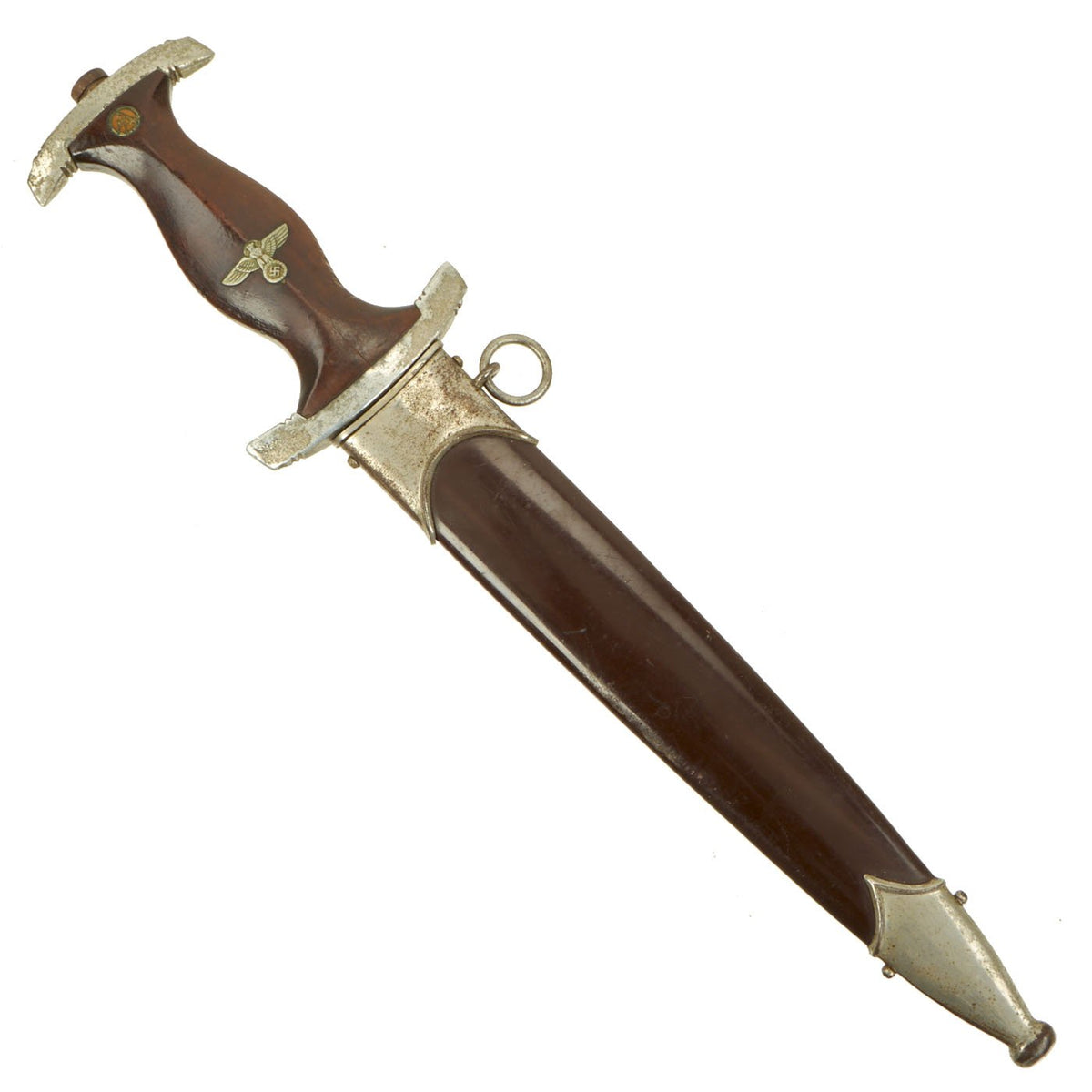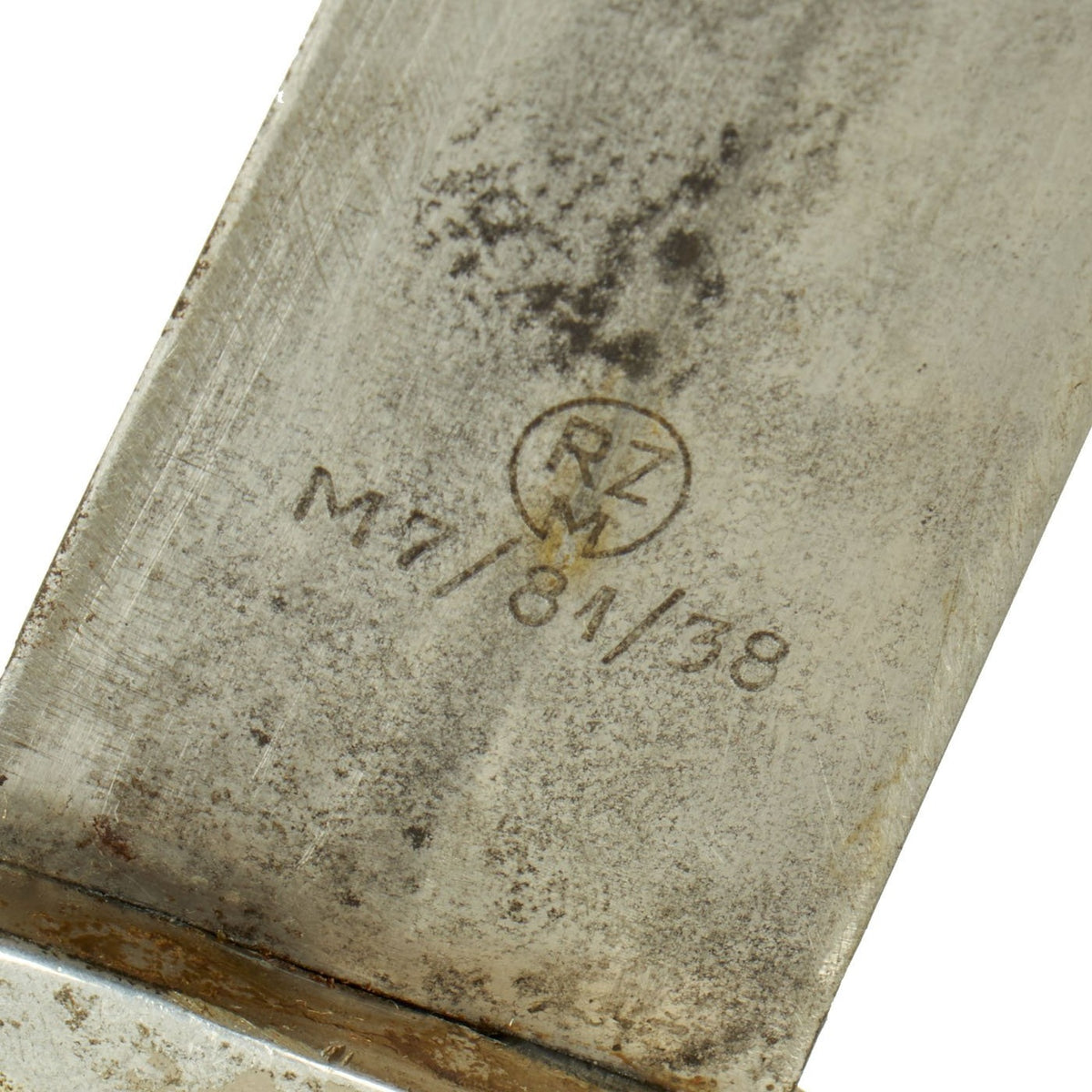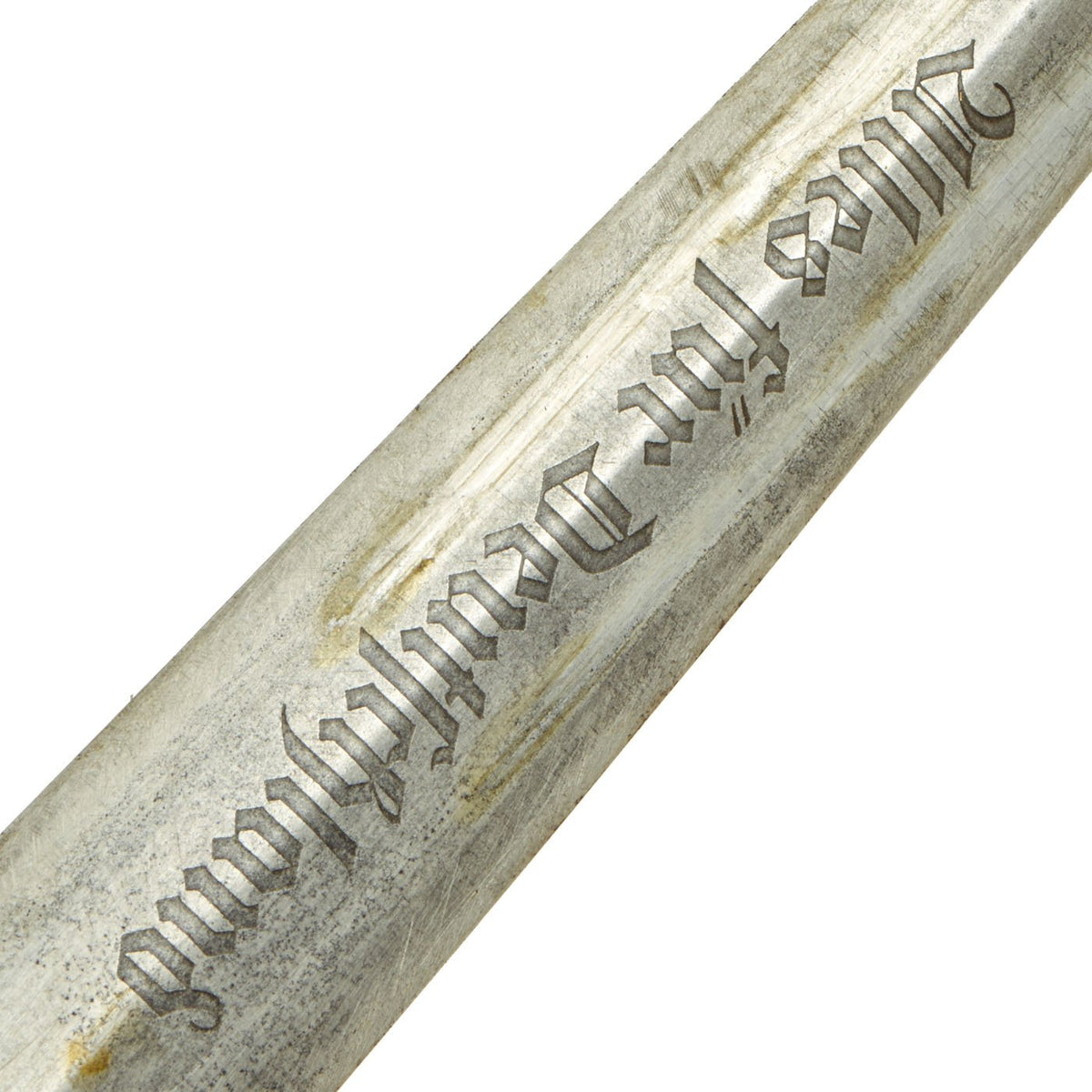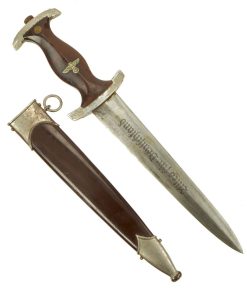Original German WWII 1938 dated SA Dagger by Rare Maker Karl Tiegel with Scabbard – RZM M7/81/38 Original Items
$ 895,00 $ 223,75
Original Item: Only One Available. This very nice condition 1938 produced SA Dagger is made with nickel-plated fittings throughout. The crossguards and tang nut are made from alloy, most likely aluminum-based, and still have much of the original plating intact. There is overall oxidation and light bubbling on the fittings, as well as some flaking and wear in areas, showing the aluminum base metal clearly. The tang nut looks to be made from plated steel, now mostly oxidized, and the hilt is still tight to the blade.
The grip is a fine product having a fine reddish colored mahogany tone in the surfaces and having medium center ridge construction. This grip is in very good condition with great grain, and fits the guards well. There are some small dents from service, and there are cracks on both sides next to the crossguard. The grip also has a varnish finish, which is somewhat worn. The SA symbol button is nicely set having mostly intact enameling, while the plating is mostly worn away and oxidized. The details are still there to the inlaid eagle, including the beak, breast feathering, wing feathering, talons, wreath and mobile swas (hook cross).
The blade of this example is in good condition, though it definitely does show wear from use and age. The edge looks to have been sharpened, so it was put into service either during or post war as a cutting implement. There is some of the original factory cross grain visible on various parts of the blade, but also runner and cleaning wear, as well as light staining. The acid-etched Alles für Deutschland (Everything for Germany) SA motto is still quite crisp, with the factory darkening retained at about 40%.
The rear is etched with the RZM contract information:
(RZM)
M7 / 81 / 38
This marking indicates the dagger was made by RZM Dagger contractor “81”, which records show is the rare maker Karl Tiegel, Tiegelwerk (Tiegel Works), located in Riemberg, then part of the Schlesien Bezirk (Silesian District) Breslau. Post-war this area was returned to Poland, and is now known as Rościsławice, and is part of the Lower Silesian Vovoidship. Tiegel also operated a depot in Solingen-Gräfrath, part of the legendary “City of Blades” in western Germany. Per J. Anthony Carter’s fine work GERMAN SWORD AND KNIFE MAKERS, this metalworking business was first founded in 1877 to produce butchers’ kitchen and professional knives. They produced some SA and NSKK daggers during WWII, first with their own trademark during the early years, and later with their RZM code during the 1938-1940 period. This is the only example of a Karl Tiegel edged weapon that we have ever seen, and the firm is assumed to have been abandoned and probably destroyed during the Russian advance in 1945.
The Reichszeugmeisterei (National Quartermaster’s Office), or RZM, was was based at the Brown house in Munich and NSDAP party headquarters in Berlin. The RZM ensured that the manufacturers of military items were consistent in design, quality of materials and other characteristics of the items. It also defined standards of design, manufacturing and quality and published an authoritative color chart for textiles. The M7 in the code stands for knives/daggers, contractor 81 stands for Carl Schmidt Sohn of Solingen.
The scabbard shell is straight throughout and has very good original brown enamel paint. It has just a bit of scuffing and the usual crazing in the finish, with only small areas of finish loss. The scabbard shell is equipped with matching plated steel mounts, which are in good condition overall, with some light wear and oxidation.. There is some very light denting of the ball on the chape, which is typical. They nicely match the crossguards and are complete with all four dome head screws, though the lower screws have definitely had the heads damaged a bit.
An very nice example of 1938 dated SA dagger from a rare maker, complete with scabbard. Ready to display!
Specifications:
Blade Length: 8 3/4″
Overall length: 13 3/4”
Crossguard: 3”
Scabbard Length: 10”
History of the SA-
The SA or Brown Shirts, were a private political formation which Adolf AH and the NSDAP used to maintain order at organized Party meetings and demonstrations. The group was formed in 1921, and grew to a huge force of nearly 3,000,000 men by the later 1930’s. To instill esprit de corps, as well as create employment for the Blade City of Solingen, it was decided each SA man would carry a dagger with his Brown Shirt uniform. Huge quantities needed to be produced to accommodate the demand. The dagger initially was produced of hand-fitted nickel mounts with attractive finished wood grip and brown anodized (a bluing process) finished scabbard.
The blade was etched with the SA motto, Alles für Deutschland. Examples produced prior to 1935 were stamped with the German sector of the SA group on reverse lower crossguard. Later examples underwent standardization through the RZM ministry. These pieces were produced of cheaper plated zinc-base fittings and scabbards were simply painted brown.
Prior to his “unmasking” as a traitor, Ernst Röhm was the leader of the SA. In 1934, he distributed approximately 100,000 SA daggers with his personal inscription on the reverse blade. These daggers were to honor individuals who had served with the SA prior to December, 1931. Other than the inscription, these pieces were identical to the standard M1933 SA dagger. After the Röhm purge, the inscription was ordered to be removed. Many examples were returned to the factory for grinding. Others were simply ground in the field by whatever means were available. Examples will occasionally be encountered with remnants of the original inscription remaining on the blade, but mostly none will remain. Some blades exist with an intact inscription, reflecting only the removal of the Röhm signature. Very very rarely is an example seen with a full, untouched inscription, as the holder would have surely risked a charge of treason.
Fast Shipping with Professional Packaging
Thanks to our longstanding association with UPS FedEx DHL, and other major international carriers, we are able to provide a range of shipping options. Our warehouse staff is expertly trained and will wrap your products according to our exact and precise specifications. Prior to shipping, your goods will be thoroughly examined and securely secured. We ship to thousands clients each day across multiple countries. This shows how we're dedicated to be the largest retailer on the internet. Warehouses and distribution centres can be located throughout Europe as well as the USA.
Note: Orders with more than one item will be assigned a processing date depending on the item.
Before shipping before shipping, we'll conduct a thorough inspection of the items you have ordered. Today, the majority of orders will be delivered within 48 hours. The delivery time will be between 3-7 days.
Returns
The stock is dynamic and we cannot completely manage it because multiple stakeholders are involved, including our factory and warehouse. So the actual stock may alter at any time. It's possible that you may not receive your order once the order has been made.
Our policy is valid for a period of 30 days. If you don't receive the product within 30 days, we are not able to issue a refund or an exchange.
You can only return an item if it is unused and in the same state as the day you received it. You must have the item in its original packaging.
Related products
Uncategorized
Uncategorized
Uncategorized
Uncategorized
Angolan Rebel 1970s era 60mm Inert Display Mortar from Angolan Civil War Original Items
Uncategorized
Uncategorized
Uncategorized
Armored Burgonet Helmet & Polearm from Scottish Castle Leith Hall Circa 1700 Original Items
Uncategorized
Uncategorized
Uncategorized
Uncategorized
Uncategorized
Australian WWII Owen MK1 Machine Carbine SMG Custom Fabricated Replica with Sling Original Items
Uncategorized
Uncategorized
Uncategorized
Uncategorized
Uncategorized
Uncategorized
Uncategorized
Uncategorized
